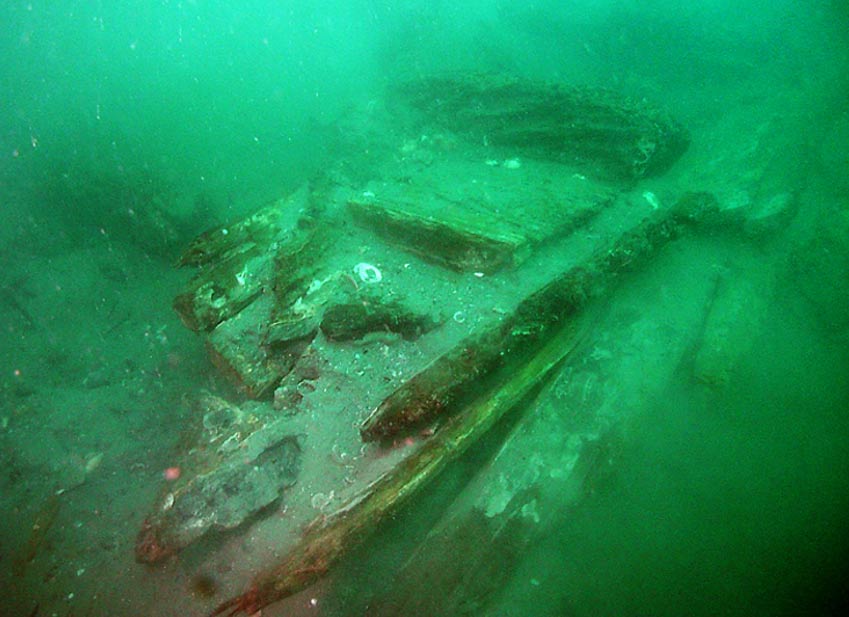Second shipwreck from Mongolian invasion of Japan found on seabed
A second ship and many artifacts from the Mongolian fleet that tried to conquer Japan in 1281 have been found on the sea floor, researchers said. Mongolian invasions in 1274 and 1281 AD ended in disaster when typhoons destroyed the fleets as they approached Japan.
Archaeology Professor Yoshifumi Ikeda of the University of Ryukyus said his team has found three other potential shipwreck locations. In all, this would make five ships from the Mongolian invasion potentially found since 2011. Ikeda and archaeologists from his institution are working with archaeologists with the Matsuura City board of education.
Archaeologists think the ship was from the Mongolian fleet in part because of the way it was constructed, the Asahi Shimbun reported.
The latest find was 200 meters (656 feet) offshore from Takashima Island in 15 meters (49 feet) of water. The ship measures 12 meters by 3 meters (39 feet by 9.84 feet). Ikeda's team found it in the fall of 2014, 1.7 km (1 mile) west of the 2011 discovery.
The Medieval Japanese believed the typhoons had been sent from the gods to protect them from their enemies and called them Kamikaze (‘divine wind’).

Fūjin-raijin-zu by Tawaraya Sōtatsu. The gods who were believed to have protected Japan with typhoons were Raijin, left, and Fujin, right. (Wikipedia)
Following the conquest of China in 1230 and Korea in 1231, Kublai Khan become the first emperor of Mongolia. Japan was just 100 miles away, feared an invasion and had reason to. Between 1267 and 1274, Kublai Khan sent numerous messages to the emperor of Japan demanding that he submit to the Mongols or face invasion. However, the messengers were blocked by Japan’s shogun, the real power behind the throne, and they never reached the Emperor.
Kublai Khan became furious that he never received a reply from the emperor, who he referred to as “ruler of a small country,” and he vowed to invade Japan. The Mongols set to work on building an enormous fleet of warships and recruited thousands of warriors from China and Korea.
In the Autumn of 1274, the Mongols launched their first invasion on Japan, which has become known as the Battle of Bun'ei. An estimated 500 to 900 vessels and 40,000 warriors, mostly ethnic Chinese and Koreans reached the shores of Hakata Bay, where the two forces met. The Mongols devastated the Japanese forces who began to retreat. However, fearing the Japanese were getting ready to return with reinforcements, the Mongols retreated to their ships. That night, the typhoon struck as the ships lay at anchor in Hakata Bay. By daybreak, only a few ships remained. The rest were destroyed, taking the lives of thousands of Mongols with them.

Featured image: The First Mongol Invasion of Japan. (Image source)
While the Japanese had a lucky escape in 1274, it was not over yet. The Mongols were now more determined than ever to conquer Japan. They worked hard to rebuilt their fleet and recruit greater numbers of warriors. Meanwhile, Japan built 2-meter-high (6 feet) walls to protect themselves from future attacks. Seven years later, the Mongols returned with an enormous fleet of 4,400 ships and an estimated 70,000 to 140,000 soldiers.
One set of forces set out from Korea, while another set sail from southern China, converging near Hakata Bay in August, 1281. Unable to find any suitable landing beaches because of the walls, the fleet stayed afloat for months and depleted their supplies. On August 15, the Mongols prepared to launch their assault on the much smaller Japanese forces defending the island. However, once again, a typhoon hit, wrecking the Mongol fleet and once again foiling the invasion attempt.
According to Japanese legend, the Kamikaze (divine wind) was created by Raijin, god of lightning, thunder, and storms, to protect Japan against the Mongols. One of the oldest Japanese deities, Raijin is an original Shinto god, also known as kaminari (from kami “spirit” or “deity” and nari “thunder"). He is typically depicted as a demon-looking spirit beating drums to create thunder. Another variation of the legend says the Kamikaze typhoons were created by Fujin (the wind god).
Featured image: The front of the shipwreck believed to be from a failed 1281 Mongolian invasion on the sea floor off a Japanese island (Photo by University of Ryukyus and the Matsuura City board of education)
By Mark Miller



















